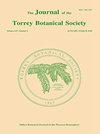Ecological life history of the facultative woodland biennial Arabis laevigata variety laevigata (Brassicaceae): reproductive phenology and fecundity
IF 0.8
4区 生物学
Q4 PLANT SCIENCES
引用次数: 5
Abstract
THOMAS C. BLOOM, JERRY M. BASKIN, AND CAROL C. BASKIN (School of Biological Sciences, University of Kentucky, Lexington, Kentucky 40506-0225, 1209 Glade Street, College Station, Texas 77840, Department of Agronomy, University of Kentucky, Lexington, Kentucky 40546-0091). J. Torrey Bot. Soc. 129: 29-38. 2002.We investigated reproductive phenology and fecundity in a population of the facultative biennial Arabis laevigata var. laevigata over a 2-year period in its rocky deciduous woodland habitat in northcentral Kentucky, USA. In contrast to most facultative biennials, A. laevigata grows in a habitat that may remain stable for a long period of time. Bolting (flower stalk elongation) occurred in March, anthesis peaked in mid April, and seeds matured in June/July. Probability of bolting increased with rosette size, which was highly correlated with number of seeds produced. Only 150 of 233 (64.4%) bolted plants monitored in 1986 and 1987 survived and produced seeds. Adults in 1987 produced taller flower stalks, more siliques per plant, longer siliques, and more seeds per plant than did adults in 1986. Arabis laevigata is similar to other facultative biennials in that onset of reproduction is size-dependent, not age-dependent, and fecundity is positively correlated with rosette size at time of reproduction.兼性林地二年生阿拉伯菜(芸苔科)的生态生活史:繁殖物候和繁殖力
THOMAS C. BLOOM, JERRY M. BASKIN和CAROL C. BASKIN(肯塔基大学生物科学学院,肯塔基州列克星敦40506-0225,大学站Glade街1209号,德克萨斯州77840,肯塔基大学农学系,肯塔基州列克星敦40546-0091)。托里·博特。社会学。129:29-38。2002.在美国肯塔基州中北部的石质落叶林地生境中,研究了兼生二年生阿拉伯树(Arabis laevigata) 2年的繁殖物候和繁殖力。与大多数兼性二年生植物不同,a . laevigata生长在一个可以长时间保持稳定的栖息地。3月抽苔,4月中旬开花,6、7月种子成熟。结茎大小与结籽数高度相关,结茎概率随结茎大小的增加而增加。在1986年和1987年监测的233株栓栽植物中,只有150株(64.4%)存活并结籽。与1986年的成虫相比,1987年的成虫的花柄更高,单株的角果更多,单株的角果更长,单株的种子更多。阿拉伯叶与其他兼性二年生植物相似,繁殖的开始是大小依赖的,而不是年龄依赖的,繁殖时的莲座大小与繁殖力呈正相关。
本文章由计算机程序翻译,如有差异,请以英文原文为准。
求助全文
约1分钟内获得全文
求助全文
来源期刊
CiteScore
0.70
自引率
0.00%
发文量
16
审稿时长
>12 weeks
期刊介绍:
The Journal of the Torrey Botanical Society (until 1997 the Bulletin of the Torrey Botanical Club), the oldest botanical journal in the Americas, has as its primary goal the dissemination of scientific knowledge about plants (including thallopyhtes and fungi). It publishes basic research in all areas of plant biology, except horticulture, with an emphasis on research done in, and about plants of, the Western Hemisphere.

 求助内容:
求助内容: 应助结果提醒方式:
应助结果提醒方式:


